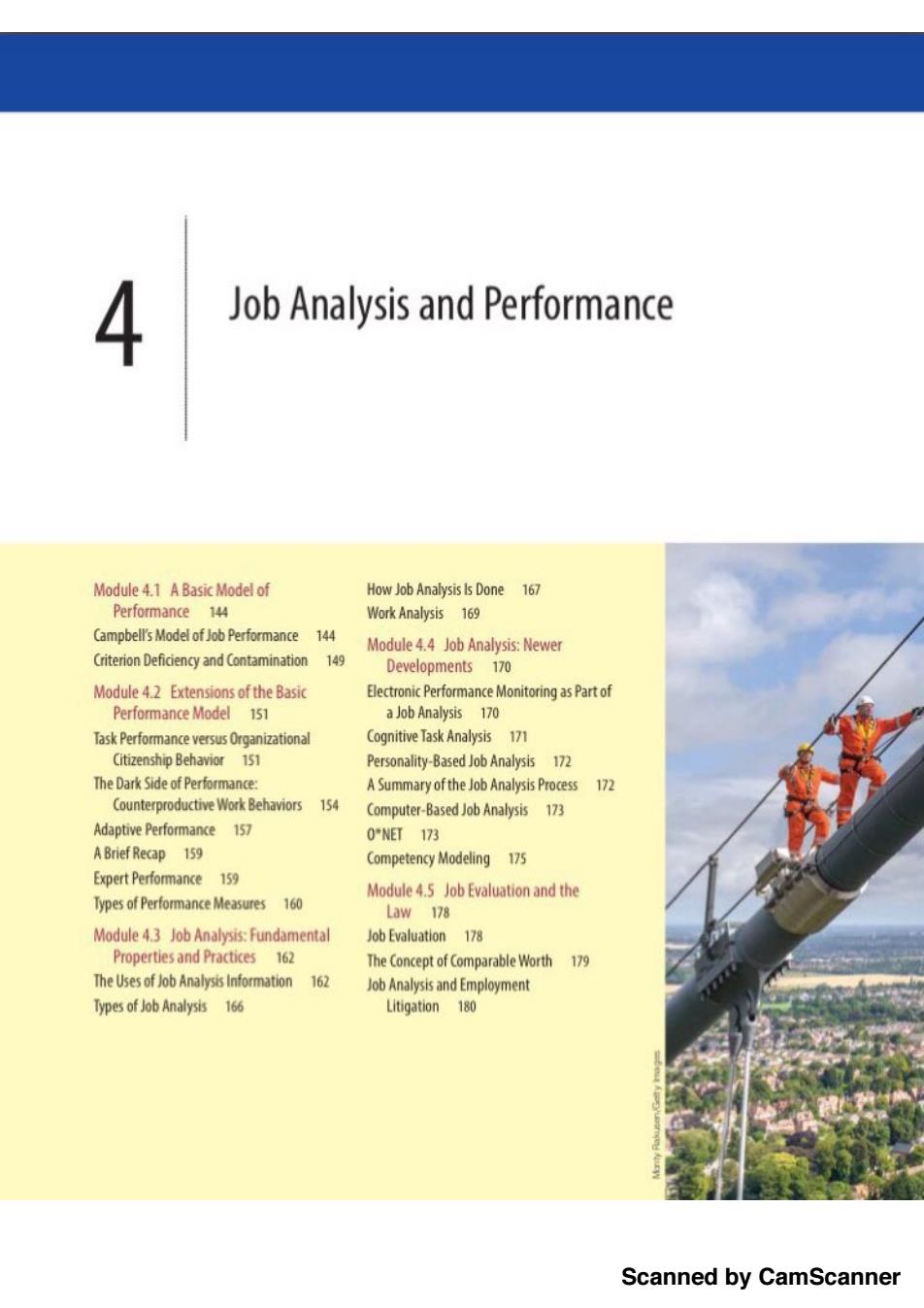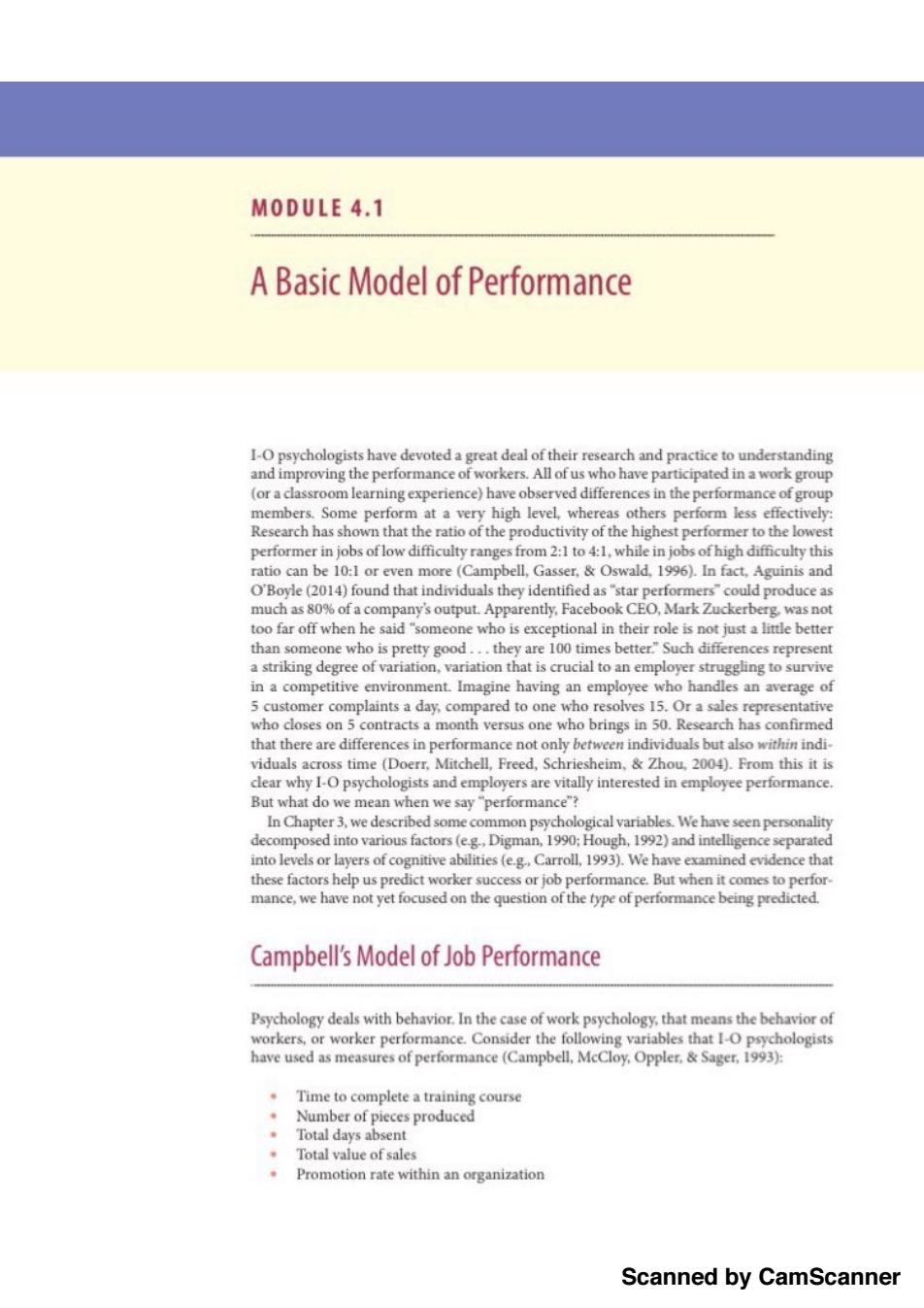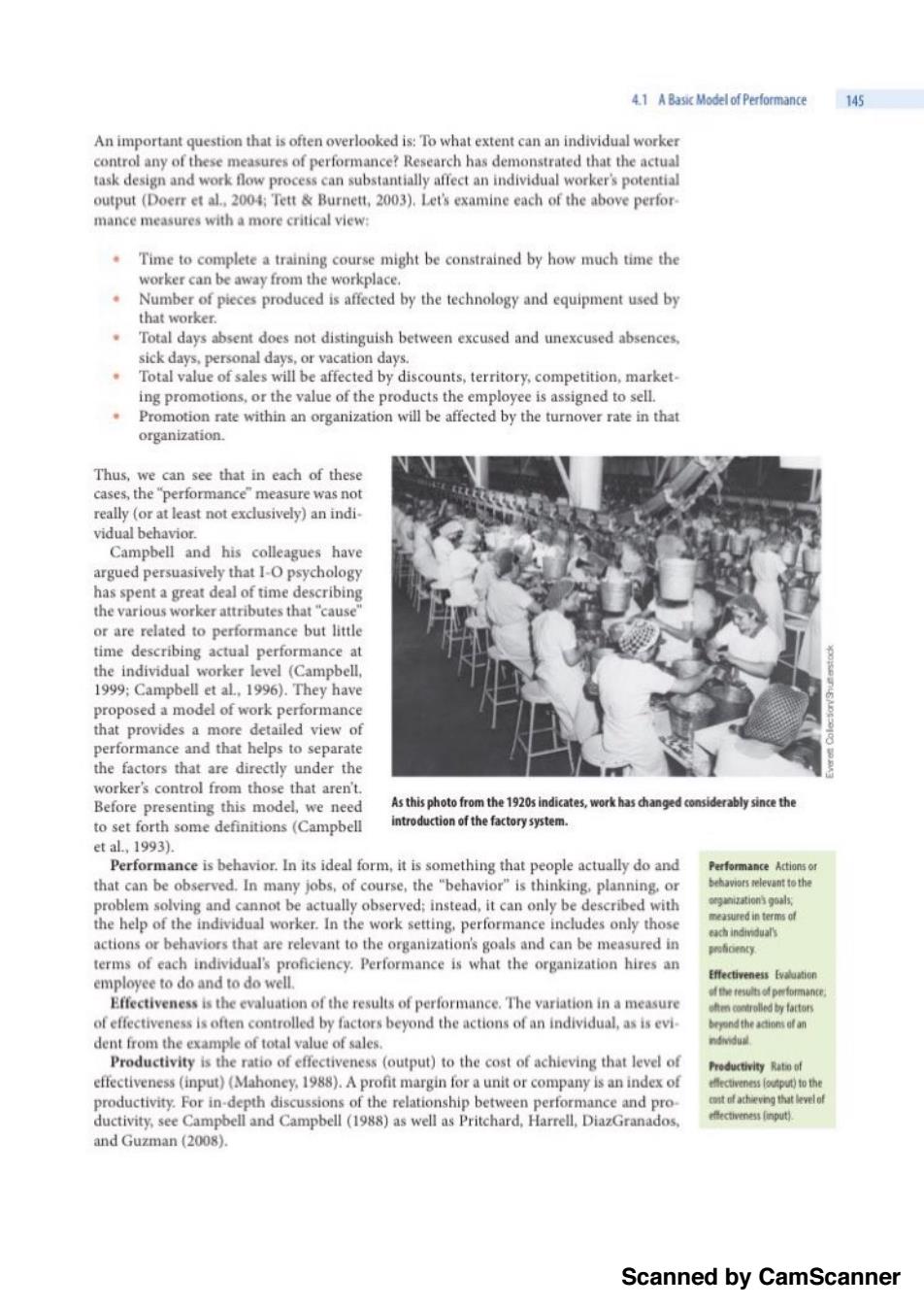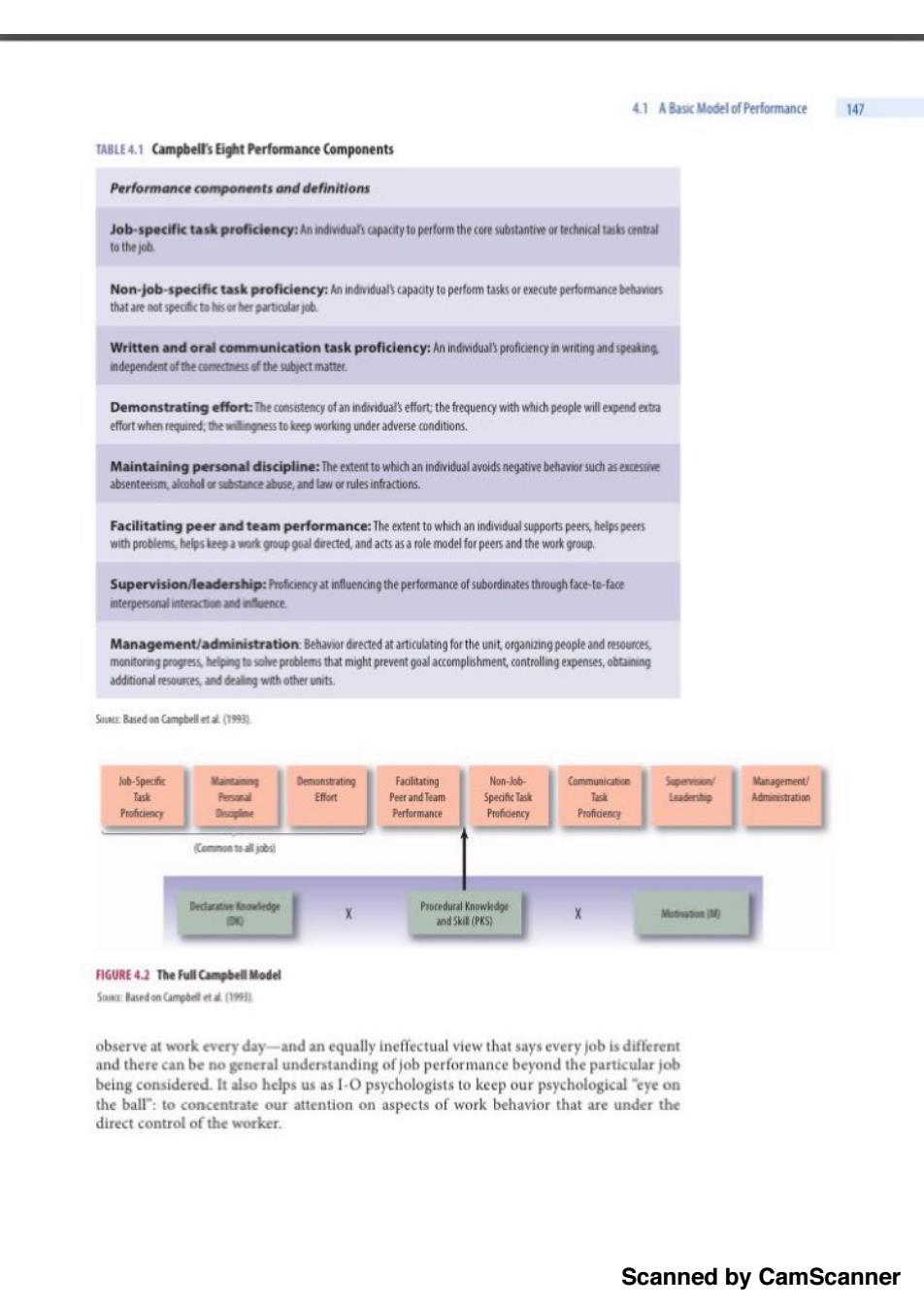
4 Job Analysis and Performance Module 4.1 A Basic Model of How Job Analysis Is Done 167 Performance 144 Work Analysis 169 Campbell's Model of Job Performance 144 Module 4.4 Job Analysis:Newer Criterion Deficiency and Contamination 149 Developments 170 Module 4.2 Extensions of the Basic Electronic Performance Monitoring as Part of Performance Model 151 a Job Analysis 170 Task Performance versus Organizational Cognitive Task Analysis 171 Citizenship Behavior 151 Personality-Based Job Analysis 172 The Dark Side of Performance: A Summary of the Job Analysis Process 172 Counterproductive Work Behaviors 154 Computer-Based Job Analysis 173 Adaptive Performance 157 0*NET173 A Brief Recap 159 Competency Modeling 175 Expert Performance 159 Module 4.5 Job Evaluation and the Types of Performance Measures 160 Law 178 Module 4.3 Job Analysis:Fundamental Job Evaluation 178 Properties and Practices 162 The Concept of Comparable Worth 179 The Uses of Job Analysis Information 162 Job Analysis and Employment Types of Job Analysis 166 Litigation 180 Scanned by CamScanner
Scanned by CamScanner

MODULE 4.1 A Basic Model of Performance 1-O psychologists have devoted a great deal of their research and practice to understanding and improving the performance of workers.All of us who have participated in a work group (or a classroom learning experience)have observed differences in the performance of group members.Some perform at a very high level,whereas others perform less effectively: Research has shown that the ratio of the productivity of the highest performer to the lowest performer in jobs of low difficulty ranges from 2:1 to 4:1,while in jobs of high difficulty this ratio can be 10:1 or even more(Campbell,Gasser,Oswald,1996).In fact,Aguinis and O'Boyle(2014)found that individuals they identified as"star performers"could produce as much as 80%of a company's output.Apparently,Facebook CEO,Mark Zuckerberg was not too far off when he said "someone who is exceptional in their role is not just a little better than someone who is pretty good...they are 100 times better."Such differences represent a striking degree of variation,variation that is crucial to an employer struggling to survive in a competitive environment.Imagine having an employee who handles an average of 5 customer complaints a day,compared to one who resolves 15.Or a sales representative who closes on 5 contracts a month versus one who brings in 50.Research has confirmed that there are differences in performance not only between individuals but also within indi- viduals across time (Doerr.Mitchell,Freed,Schriesheim.Zhou.2004).From this it is clear why I-O psychologists and employers are vitally interested in employee performance. But what do we mean when we say "performance"? In Chapter 3,we described some common psychological variables.We have seen personality decomposed into various factors(e.g.,Digman,1990:Hough,1992)and intelligence separated into levels or layers of cognitive abilities (e.g Carroll,1993).We have examined evidence that these factors help us predict worker success or job performance.But when it comes to perfor mance,we have not yet focused on the question of the type of performance being predicted. Campbell's Model of Job Performance Psychology deals with behavior.In the case of work psychology,that means the behavior of workers,or worker performance.Consider the following variables that I-O psychologists have used as measures of performance(Campbell,McCloy,Oppler.Sager,1993): Time to complete a training course Number of pieces produced Total days absent .Total value of sales Promotion rate within an organization Scanned by CamScanner
Scanned by CamScanner

4.1 A Basic Model of Performance 145 An important question that is often overlooked is:To what extent can an individual worker control any of these measures of performance?Research has demonstrated that the actual task design and work flow process can substantially affect an individual worker's potential output (Doerr et al 2004;Tett Burnett,2003).Let's examine each of the above perfor- mance measures with a more critical view: Time to complete a training course might be constrained by how much time the worker can be away from the workplace. Number of pieces produced is affected by the technology and equipment used by that worker. Total days absent does not distinguish between excused and unexcused absences, sick days,personal days,or vacation days. Total value of sales will be affected by discounts,territory,competition,market- ing promotions,or the value of the products the employee is assigned to sell. Promotion rate within an organization will be affected by the turnover rate in that organization. Thus,we can see that in each of these cases,the "performance"measure was not really (or at least not exclusively)an indi. vidual behavior. Campbell and his colleagues have argued persuasively that I-O psychology has spent a great deal of time describing the various worker attributes that cause' or are related to performance but little time describing actual performance at the individual worker level (Campbell, 1999;Campbell et al.,1996).They have proposed a model of work performance that provides a more detailed view of performance and that helps to separate the factors that are directly under the worker's control from those that aren't. Before presenting this model,we need As this photo from the 1920s indicates,work has changed considerably since the to set forth some definitions(Campbell introduction of the factory system. etal,1993). Performance is behavior.In its ideal form,it is something that people actually do and Performance Actions or that can be observed.In many jobs,of course,the "behavior"is thinking,planning.or behaviors elevant tothe problem solving and cannot be actually observed;instead,it can only be described with eganization goals the help of the individual worker.In the work setting.performance includes only those easured i销emG ach indidual小 actions or behaviors that are relevant to the organization's goals and can be measured in preficenty terms of each individual's proficiency.Performance is what the organization hires an employee to do and to do well. Effectiveness Evaluation hresultof pformnce Effectiveness is the evaluation of the results of performance.The variation in a measure coredbyfartors of effectiveness is often controlled by factors beyond the actions of an individual,as is evi- beyond the actinns af an dent from the example of total value of sales. Productivity is the ratio of effectiveness (output)to the cost of achieving that level of Preductivity Ratio o! effectiveness (input)(Mahoney,1988).A profit margin for a unit or company is an index of ectiveness fouput)to the productivity.For in-depth discussions of the relationship between performance and pro- ofachieving that levelo ductivity,see Campbell and Campbell(1988)as well as Pritchard,Harrell,DiazGranados, fectiveness (mput) and Guzman(2008). Scanned by CamScanner
Scanned by CamScanner

146 Chapter4 Job Analysis and Performance Dedarative Knowledge (DK): Procedural Knowledge and Knowledge about facts and Sk作Pg5 )Knowing how to thngs an understanding of a dohn华 先键性t仇uan线e fat由 Choketo perfomm 向kaah Levelof effort G当 Self-management skill Prrsistence of etfort Sel-kowledge y fomn Theory 月GURE4.1 Campbell Determinants of Job Performance Sou:Based on Campbel 时(19931 Based on extensive research with army enlisted personnel,Campbell developed a hierarchical model of job performance(Campbell,McHenry,Wise,1990).He pos- Dedarative knowledge tulated three direct determinants of job performance:declarative knowledge (DK). D相Understanding what is procedural knowledge and skill(PKS),and motivation(M)(see Figure 4.1).By deter. equr时如perform a task minants,he means the basic building blocks or causes of performance. knowing informaticn abeut a ob or task Campbell's model also proposes that many of the variables we examined in earlier chapters and will examine in later chapters (ability.personality.interest,training Procedural knowledge and experience,motivators)have an indirect effect on performance.These variables and skill (PKS)Knowing how to perfamm a job ce can affect performance only by changing the level of DK.PKS,or M.For example task:often developed increased training or experience will affect performance by increasing DK or PKS; through practice and incentives for performance will affect performance by increasing M (inducing the experence person to perform at a higher level or to perform for a longer period of time).Similarly. Motivation (M)Concerns Tett and Burnett(2003)propose that personality,in particular conscientiousness,has a the condtons他spons恤 substantial effect on goal setting,which in turn increases declarative knowledge.They for variationsin intens suggest that this connection explains the finding (noted in Chapter 3)that con. p桌ynd drection of ongoing scientiousness has strong and positive correlations with job performance(Barrick behanor. Mount,1991,2005). There is one other important aspect to Campbell's model:actual performance compo- Determinants of performance Basic nents.DK,PKS,and M are determinants of performance,but they are not behaviors bulding bleckscausesf (i.e.they are not performance itself).Campbell's research identified eight basic performan统which are performance components (Table 4.1),some or all of which can be found in every job. dedaratve knawledge. When we combine the eight performance components with the three direct determinants proceduralknowledge.and of performance and the various indirect determinants of performance,we get an metiation. expanded model such as the one depicted in Figure 4.2.Although the model specifies Performance components eight distinct performance components,not all components will appear in all jobs. Component的atm尊 Nevertheless,the model allows performance in any job to be broken into all or some subsets of these components.Campbell asserted that three of the performance esult fom the determin.an站 components-core task proficiency,demonstrating effort,and maintaining personal discipline-are essential at some level for every job. Campbell's expanded model has a great deal of intuitive appeal as well as research sup- port(McCloy,Campbell,Cudek,1994).It occupies a valuable middle ground between found in every job a view of performance as a single broad factor-a view that contradicts what we can Scanned by CamScanner
Scanned by CamScanner

4.1 A Basic Model of Performance 147 TABLE4.1 Campbell's Eight Performance Components Performance components and definitions Job-specific task proficiency:An individual's capacity to perform the core substantive or technical tasks central to the jo地 Non-job-specific task proficiency:An indiiduals capaaty to perfomm tasks or execute perfommance behavers that are not specificte his er her particular job. Written and oral communication task proficiency:An indnidual's proficency in writing and speaking independent of the cmectness of the subiect matter. Demonstrating effort:The cosy of an indvidualseffort the frequency with which people will expendea effort when required theess to keep working under adverse conditions. Maintaining personal discipline:The extenttowhich an indvidualavodsnegative behavors absenteeism alcoholrtne abuse,and law or rules infractions. Facilitating peer and team performance:The extent to which an individual supports peers,helps peers withproblemhelpsedected,and acts asa role model for peersand the workgroup Supervision/leadership:Proficiency at influencing the performance of subordinates through face-to-face nterpersonal interaction and infuence Management/administration:Behavior drected at articulating for the unit,organizing people and resoues mepsve prblems that might prevent goalaccomplshment,controlng expenses dditional resources and dealing with other units SuEB超ed on Campbellet Job-Specific Faolitating Non-lb- Communicatce Management/ Task Effort Peerand Team Specific Task a Performance Profioency Profidency Decarate Kouedg Procedural Knowldoe 趋d5 k(PKS) Mueuton FIGURE 4.2 The Full Campbell Model Sama:Based on Camobell eta993 observe at work every day-and an equally ineffectual view that says every job is different and there can be no general understanding of job performance beyond the particular job being considered.It also helps us as I-O psychologists to keep our psychological "eye on the ball":to concentrate our attention on aspects of work behavior that are under the direct control of the worker. Scanned by CamScanner
Scanned by CamScanner